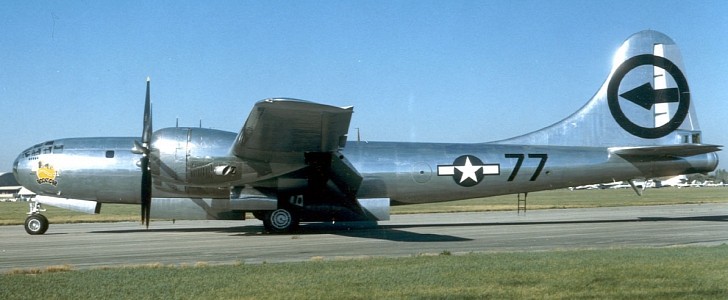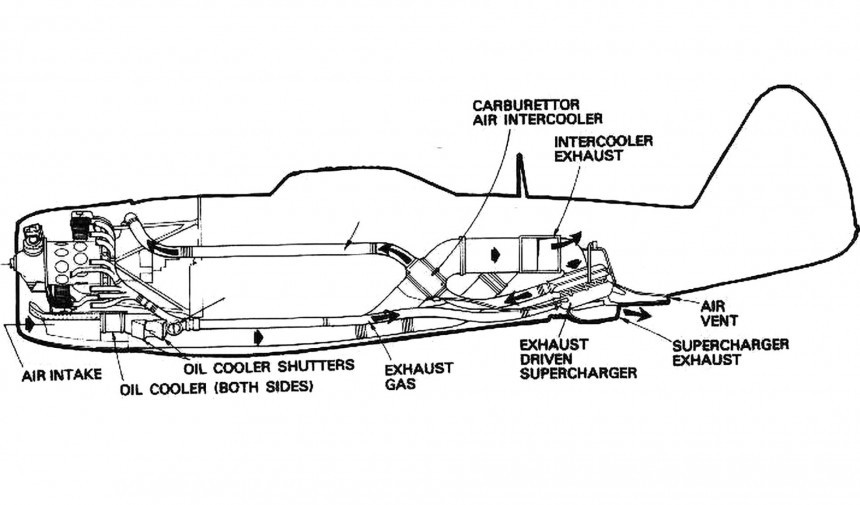You won’t win any races if you are out of breath, so that’s why aviation and automakers embraced forced induction to win the second World War
Somehow my grandfather survived 31 missions over Nazi Germany. As Lead Navigator of the Mighty 8th Air Force, one of his side jobs was to monitor the intercooler flaps. Each of the four 14-cylinder beasts made 1,000 horsepower thanks to massive turbos. Germans would target the turbos because they were the size of a garbage can with hot oil bearings, so a visual inspection was critical every few minutes.
Japan, Germany, and Italy started a war with 1930s technology, and this often-meant inferior power for their aircraft. Over the Pacific, the Japanese Zero was built by Mitsubishi to be as light as possible. This means no protection for the pilot or the gas tanks, and no room for turbos. This is when the geniuses at Republic decided to build the world’s largest single-engine fighter, and they designed it around the world’s largest turbo. Instead of being small and nimble, the P47 Thunderbolt was a single-seat tank. In addition to carrying 2,500 pounds of bombs, it has 8 Browning .50 caliber machine guns. Plates of steel protect the pilot, the tanks, and the 2,000 horsepower, 46-liter monster.
As you can see, the intercooler is larger than a stack of pallets with wastegates the size of basketballs. Behind the dash was a tank of watered-down methanol that was sprayed into the intercooler for the ultimate over-boost system. When activated, the pilot could push this 5-ton lady around like a ballerina to jump behind the unfortunate enemy. On the other side of the world, Germany had superchargers on their V12 engines, but the pulley ratio (and boost) were set at the factory for maximum performance at low altitude. Thanks to our allies at Rolls-Royce, the North American P-51 used a 2-speed blower with settings for speed and and altitude.
Much like today, boost is made by spinning a compressor. If it is crank driven, you have a supercharger while turbos use exhaust gases to accomplish the same task. A hybrid of both types combined the best features of both to become the "turbosupercharger" and it is the predecessor of all modern forced induction. Grandpa and his crew had to endure many hours at 48 degrees below zero (-44C) when cruising at high altitudes because the B-17 and the B-24 were not pressurized.
Back over to the Pacific, the Boeing B-29 made use of extra boost by using the inboard turbos of each inboard engine to pressurize the cockpit to an equivalent of 8,000 feet (2,438m). Before heading to the intercooler, a valve dumped warm air on to the tail-gunner (lucky) and it was held in by a tunnel he could crawl through to reach the cockpit. This protected the crew from freezing in an emergency and 8,000 feet became the standard for passenger aircraft pressurization.
With Germany and England’s unveiling of jet engines, the end of the piston engine was on the horizon. The invasion of Japan was expected to cost a million lives at least, so one last generation of pistons and turbos was needed. A turbo-compound engine uses exhaust to spin a driveshaft into a planetary gearbox.
The 3000:1 reduction is geared directly to the crankshaft to help spin the propeller in what they called a power recovery turbine. Three of these on each engine are combined to transform 55 liters of displacement into 3,700 horsepower, an engine that powered the airlines for another twenty years.
Turbine and compressor technology made incredible leaps during the 40s, and they became more efficient than the piston engines they were attached to. Because of this, engineers looked for an easier way to introduce heat between the hot and cold sides. The answer was the jet engine, and the rest is history.
Japan, Germany, and Italy started a war with 1930s technology, and this often-meant inferior power for their aircraft. Over the Pacific, the Japanese Zero was built by Mitsubishi to be as light as possible. This means no protection for the pilot or the gas tanks, and no room for turbos. This is when the geniuses at Republic decided to build the world’s largest single-engine fighter, and they designed it around the world’s largest turbo. Instead of being small and nimble, the P47 Thunderbolt was a single-seat tank. In addition to carrying 2,500 pounds of bombs, it has 8 Browning .50 caliber machine guns. Plates of steel protect the pilot, the tanks, and the 2,000 horsepower, 46-liter monster.
Much like today, boost is made by spinning a compressor. If it is crank driven, you have a supercharger while turbos use exhaust gases to accomplish the same task. A hybrid of both types combined the best features of both to become the "turbosupercharger" and it is the predecessor of all modern forced induction. Grandpa and his crew had to endure many hours at 48 degrees below zero (-44C) when cruising at high altitudes because the B-17 and the B-24 were not pressurized.
Back over to the Pacific, the Boeing B-29 made use of extra boost by using the inboard turbos of each inboard engine to pressurize the cockpit to an equivalent of 8,000 feet (2,438m). Before heading to the intercooler, a valve dumped warm air on to the tail-gunner (lucky) and it was held in by a tunnel he could crawl through to reach the cockpit. This protected the crew from freezing in an emergency and 8,000 feet became the standard for passenger aircraft pressurization.
The 3000:1 reduction is geared directly to the crankshaft to help spin the propeller in what they called a power recovery turbine. Three of these on each engine are combined to transform 55 liters of displacement into 3,700 horsepower, an engine that powered the airlines for another twenty years.
Turbine and compressor technology made incredible leaps during the 40s, and they became more efficient than the piston engines they were attached to. Because of this, engineers looked for an easier way to introduce heat between the hot and cold sides. The answer was the jet engine, and the rest is history.









